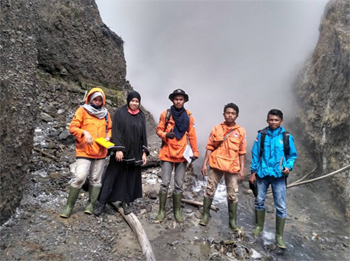Petrography Volcanic Rock: Volcanic Rock Alteration Study of Colo Volcano Indonesia

Colo Volcano research team.
The existence of Colo Volcano on the southwest side of the North Arm of Sulawesi Magmatic Arc show evidence of evolutionary difference plate under Tomini Bay. Colo Volcanism activity indicated a product of slab rollback final extension of the Gulf Gorontalo. This study aims to investigate the alterated vulcanic rocks of the Colo Volcano. In this study, petrographic analysis is used to determine mineral composition based on petroscopic. Several lava and pyroclastic outcrops, indicating an alteration of the Colo Volcano product. The analysis showed andesite lava on gray-green thin incisions, subhedral-anhedral shape, mineral composition consist of hornblende (10%), biotite (10%), quartz (15%), pyroxene (10%), orthoclase (10%), Plagioclase (10%), opaque minerals (20%) and glasses (15%). The Orthoclase, is white-blueish-gray, orthorhombic, low cleavage, twinning altered look. Locally shows colorless-blue-grayish, subhedral-anhedral shape, mineral composition consisting of hornblende (10%), biotite (10%), quartz (50%), pyroxene (5%), orthoclase (5%), opaque minerals (15%) and glasses (5%). It might consist of cholorotisation of biotite. The lava exposed on Mount Ambu shows the presence of smectite alteration and pyrite mineralization, on thin incisions including blue-gray-brown, subhedral-anhedral shape, mineral composition consist of hornblende (10%), biotite (5%), quartz (10%), Olivine (5%), plagioclase (20%), orthoclase (15%), opaque minerals (15%) and glasses (20%).
Keywords: Petrography, Colo Volcano, Indonesia, volcanic rock, alteration.
Amin, A.K.M.A., Badaru, A.W.W., Manyoe, I.N., Salama, T.H., and Laseti, K.H. 2017. Petrography Volcanic Rock : Volcanic Rock Alteration Study of Colo Volcano Indonesia. International Conference on Transdisciplinary Approach Research. Universitas Negeri Gorontalo and Ehime University Japan, Indonesia.
